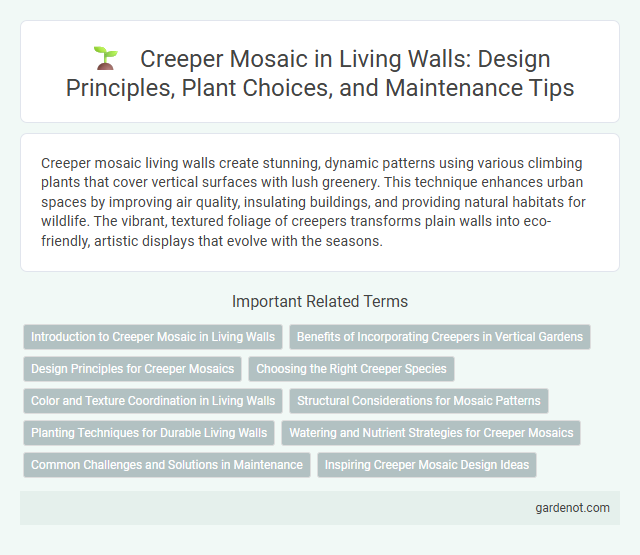Creeper mosaic living walls create stunning, dynamic patterns using various climbing plants that cover vertical surfaces with lush greenery. This technique enhances urban spaces by improving air quality, insulating buildings, and providing natural habitats for wildlife. The vibrant, textured foliage of creepers transforms plain walls into eco-friendly, artistic displays that evolve with the seasons.
Introduction to Creeper Mosaic in Living Walls
Creeper mosaic in living walls enhances vertical gardening by integrating diverse climbing plants to create intricate, natural patterns. This technique promotes biodiversity and improves air quality, while offering aesthetic appeal through dynamic, seasonal changes in foliage color and texture. The strategic arrangement of creepers enables efficient use of vertical space, contributing to urban greening and sustainable architectural design.
Benefits of Incorporating Creepers in Vertical Gardens
Creeper mosaics enhance vertical gardens by maximizing green coverage and improving air quality through natural filtration of pollutants. The dense foliage of creepers provides insulation, reducing heat absorption and lowering energy costs in urban environments. Integrating creepers also promotes biodiversity by offering habitat and food sources for pollinators and beneficial insects.
Design Principles for Creeper Mosaics
Creeper mosaics integrate organic growth patterns with geometric design, emphasizing balance and rhythm to create visually appealing living walls. Strategic placement of different creeper species ensures color contrast and texture variation, enhancing overall mosaic depth and vibrancy. Maintaining proportional spacing and growth direction supports sustainable plant health and longevity for the living wall structure.
Choosing the Right Creeper Species
Selecting the right creeper species for a living wall depends on factors such as climate compatibility, growth rate, and maintenance requirements. Popular options include English ivy (Hedera helix) for its evergreen leaves and vigorous growth, Boston ivy (Parthenocissus tricuspidata) for seasonal color changes, and Virginia creeper (Parthenocissus quinquefolia) for its adaptability and lush coverage. Evaluating sunlight exposure and structural support ensures optimal health and aesthetic appeal of the creeper mosaic on the living wall.
Color and Texture Coordination in Living Walls
Creeper mosaic plants exhibit a rich palette of green hues combined with variegated patterns that create dynamic color contrast in living walls. Their textured leaves range from smooth to slightly serrated edges, enhancing the tactile dimension and visual depth of vertical gardens. Strategic placement of different creeper mosaic varieties optimizes color harmony and texture diversity, promoting a balanced and vibrant living wall design.
Structural Considerations for Mosaic Patterns
Creeper mosaic patterns require careful structural consideration to ensure stability and aesthetics, involving a robust framework that supports the weight and growth trajectory of the plants. The design must integrate tension wires or grids to guide vine expansion while preventing sagging or detachment from the wall surface. Proper irrigation and drainage systems are essential within the structure to maintain healthy vegetation and prevent water damage to the underlying materials.
Planting Techniques for Durable Living Walls
Creeper mosaic living walls thrive through strategic layering and careful selection of fast-rooting, resilient creepers like Hedera helix or Parthenocissus tricuspidata. Utilizing modular planting systems with integrated irrigation ensures consistent moisture levels, promoting robust root establishment and long-term adherence. Regular pruning and the use of lightweight, nutrient-rich substrates further enhance plant health and wall durability, preventing substrate erosion and structural damage.
Watering and Nutrient Strategies for Creeper Mosaics
Creeper mosaics thrive with consistent watering that maintains moist but well-drained soil, avoiding waterlogging that can damage roots. Implementing a slow-release fertilizer rich in nitrogen, phosphorus, and potassium supports vigorous growth and vibrant foliage. Regular monitoring of soil moisture and nutrient levels ensures the mosaic's long-term health and aesthetic appeal.
Common Challenges and Solutions in Maintenance
Creeper mosaic on living walls often causes uneven growth patterns and potential damage to plant health due to viral infection transmission. Common challenges include leaf discoloration, stunted growth, and reduced photosynthesis efficiency. Regular monitoring, removing infected areas promptly, and applying appropriate antiviral treatments help maintain healthy living walls free from creeper mosaic impacts.
Inspiring Creeper Mosaic Design Ideas
Creeper mosaic designs transform plain walls into vibrant living art by integrating diverse creeping plants with varied leaf shapes, colors, and textures. Strategic layering of species like English ivy, climbing fig, and creeping jenny creates dynamic patterns that enhance vertical garden aesthetics. Incorporating geometric shapes or natural motifs in the mosaic fosters an inspiring green tapestry ideal for both indoor and outdoor living walls.
Creeper mosaic Infographic

 gardenot.com
gardenot.com